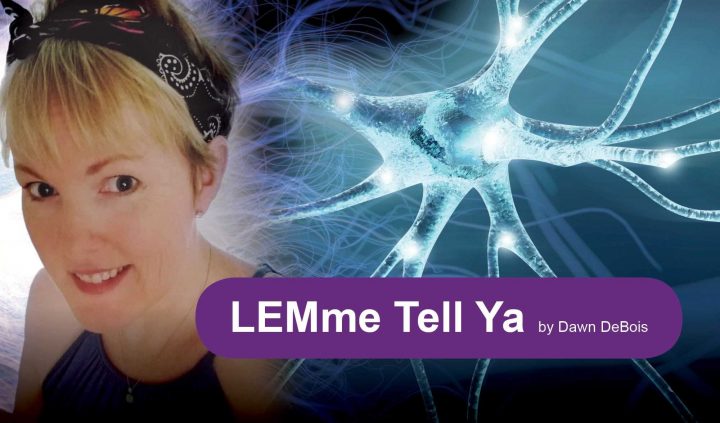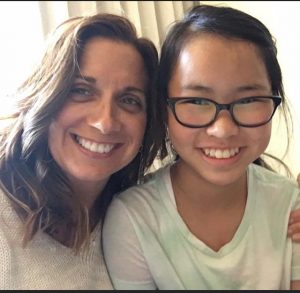‘LEMme Tell Ya’ Patient Stories in Their Mothers’ Words: Lori Dunham
Written by |

Every year since my Lambert-Eaton myasthenic syndrome (LEMS) diagnosis in 2016 has brought unexpected experiences. In the past year, my eyes have been opened to the amazing resilience of the mothers of rare disease patients.
One mother I am blessed to have become friends with is Lori Dunham, also a mom of three and a published writer. Her middle child, Grace, 14, was diagnosed with LEMS in August 2019. I am grateful Lori has agreed to share Grace’s patient story, in a mother’s words.
DD: Tell us about your mother’s intuition kicking in that something was wrong with Grace?
LD: Grace began limping while playing basketball during the 2019 season. I took her to the pediatrician thinking she had a sprained ankle. I quickly noticed the doctor’s concern when she asked Grace to squat down and then stand back up. She couldn’t do it. I knew then something was seriously wrong.
What has been most difficult about Grace’s LEMS diagnosis?
It was heartbreaking for me to see Grace literally deteriorate before my eyes, lose weight, lose the ability to walk on her own. The first time I had to put her in a wheelchair was jarring for me as her mom. For her, it was a huge relief, but as I pushed her through those hospital corridors, my eyes brimmed over with tears. How did we get here, and so quickly?
But the worst by far was when she went through deep depression before the diagnosis. She lost all hope that tomorrow would be better than today, and at 14, she expressed feeling “flat.” Getting that diagnosis and a treatment plan was the turning point in her depression.
What has been the most surprising part of Grace’s LEMS diagnosis?
Of course, I would never want this burden on my daughter’s shoulders, but on days when I have good perspective and am able to look objectively at Grace’s situation, I see so much good coming from her LEMS diagnosis.
She was a timid child, and now I see her growing in confidence to speak up for herself and for others who can’t speak for themselves. I see her empathy growing and her eyes opening to needs around her. I erroneously thought this diagnosis would make her inward-focused, but it has actually turned her eyes toward others, full of great compassion. I can see where this experience will lead her into meaningful work as she grows into adulthood.
How do you balance being Mom to a teenager who just happens to have LEMS and to your other children?
Anyone who has a loved one with a chronic illness, I believe, would say it changes the dynamics of your family unit. In the six months before diagnosis, our lives were consumed with the search. We had over 35 medical appointments during that time, along with hours of phone calls to our insurance company.
This time was definitely hardest on our 12-year-old daughter, Bethany, who oftentimes felt overlooked and forgotten. Many of her feelings were legitimate, and we validated her place in the family, but when your house is on fire, you focus on the fire, right?
Many of our family members and friends stepped in to be there for our youngest, but it still did not replace our presence in her life. We made a point to set aside time for things Bethany enjoyed and “normal” activities she wanted to do. Overall, I think it is making her more compassionate and understanding of other people’s struggles.
What advice do you have for other parents who may be starting this journey of having a child with LEMS?
First, connect with other people who have gone through what you are walking into. LEMS Facebook groups and forums have been a lifeline for me. On days when fear was smothering me, other moms of children with LEMS shared their stories and gave me hope and encouragement.
Second, fight for your child. Fight for the diagnosis, the treatment plan, the answers. We know when something is not right with our child. Grace’s neurologist assumed she had limb-girdle muscular dystrophy. I had to push him and ask the right questions for him to see beyond the most obvious and find the hidden diagnosis.
Finally, give your child hope. Fill them with life-giving words, words of hope and a bright future. Encourage them, smile, play music loudly and often, get them out in the sunshine, and do things that they can still do, instead of focusing on what they can’t. They have a full and vibrant life ahead of them!
***
Note: Lambert-Eaton News is strictly a news and information website about the disease. It does not provide medical advice, diagnosis, or treatment. This content is not intended to be a substitute for professional medical advice, diagnosis, or treatment. Always seek the advice of your physician or other qualified health provider with any questions you may have regarding a medical condition. Never disregard professional medical advice or delay in seeking it because of something you have read on this website. The opinions expressed in this column are not those of Lambert-Eaton News or its parent company, Bionews Services, and are intended to spark discussion about issues pertaining to Lambert-Eaton myasthenia.








Leave a comment
Fill in the required fields to post. Your email address will not be published.